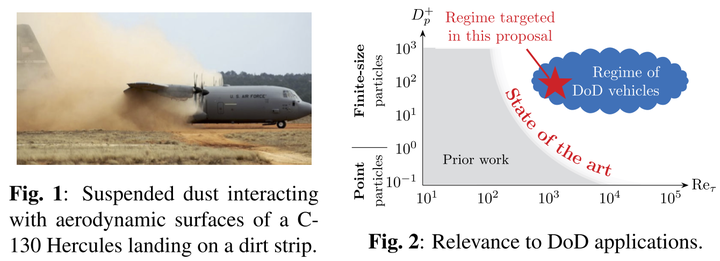Understanding the interaction of finite-size particles with aerodynamic surfaces

Funding: DOD AFOSR award #FA9550 (2025 – 2028).
The goal of the project is to understand and model the interaction of finite-size particles with aerodynamic surfaces when the coupling between the two phases is significant. Due to the feedback force from the particles on the carrier flow, particle-laden turbulent boundary layers (TBL) have dynamics that may differ considerably from those of particle-free TBL. In dusty flows (e.g. sand particles in air), the modulation of the carrier flow by the disperse phase becomes significant with solid volume fractions as low as 10-4 (or mass fractions ~0.1). Conditions like this arise when airframes operate in desert environments. As most prior work focused on very dilute conditions, where the effect of particles on the carrier flow is negligible, the current understanding of the physics in the regime where the inter-phase coupling is significant is very limited. Predicting the dynamics of dusty TBL is further complicated by the emergence of finite-size effects at high Reynolds numbers. This occurs due to the compression of flow scales in the near-wall region of a TBL with increasing Reynolds number which causes particles with typical size 20𝜇m to become larger than near-wall eddies. Currently, little is known about how such particles disperse in a TBL, how they interact with near-wall coherent structures, and how their finite-size effect can be incorporated in continuum models of particle-laden TBL.
The completion of this project will (i) significantly advance our understanding of how the disperse phase interacts with aerodynamic boundary layers, (ii) enable models capable of predicting near-surface disperse phase and dense-phase effects, and (iii) enable the development of dust mitigation strategies, dust-resilient airframes, and new technologies that increase operational range of aircrafts operating in dusty environments.
Related publications :